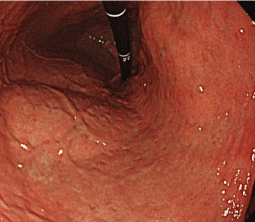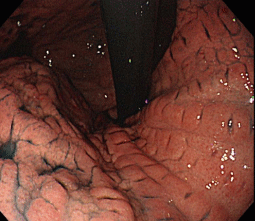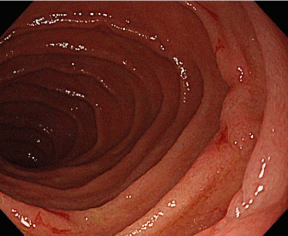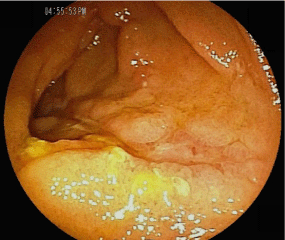Clinical Image
A Special Appearance of Gastric Mucosal Folds in Patient with Crohn's Disease: Bamboo-Like Appearance
Shiyang M1,2 Irisawa A1*, Shibukawa G1, Yamabe A1, Fujisawa M1, Sato A1, Arakawa N1, Yoshida Y1, Igarashi R1, Maki T1, Yamamoto S1, Hoshi K1, Utano K3 and Togashi K
1Department of Gastroenterology, Aizu Medical Center, Fukushima Medical University, Japan
2Division of Gastroenterology, The Second Affiliated Hospital of Xi'an Jiaotong University, China
3Department of Coloproctology, Aizu Medical Center, Fukushima Medical University, Japan
*Corresponding author: Atsushi Irisawa, Department of Gastroenterology, Aizu Medical Center, Fukushima medical University, 21-2, Maeda, Tanisawa, Kawahigashi, Aizuwakamatsu, 969-3492, Japan
Published: 04 May, 2016
Cite this article as: Shiyang M, Irisawa A, Shibukawa G,
Yamabe A, Fujisawa M, Sato A, et al. A Special Appearance of Gastric Mucosal Folds in Patient with Crohn's Disease: Bamboo-Like Appearance. Ann Clin Case Rep. 2016; 1: 1009.
Case Presentation
A 27-year-old man consulted the outpatient department with intermittent upper abdominal
discomfort for the prior 2 weeks. The patient had a history of anal incision for abscess without
relapse. Physical examination revealed mild discomfort on palpation of the upper quadrant with no
peritoneal sign. Laboratory results showed hypoproteinemia (2.7g/dL), neutrophilia (63.8%), and
slightly elevated C-reactive protein (CRP; 1.59 mg/dL). Abdominal computed tomography revealed
mild wall thickening in the terminal ileum. The appendix was not visualized. Gastro endoscopy was
performed to rule out upper digestive tract disease. Endoscopic images taken from the proximal part
of gastric body showed bamboo-like appearance (Figure 1 and 2). Colonoscopy, double-balloon
endoscopy, and capsule endoscopy were performed at the same time.Ulceration of the intestine was
identified in several locations (Figure 3).
The patient was diagnosed as having Crohn's disease (CD) based on the symptoms,
hypoproteinemia, anal abscess, and typical intestinal ulcer. The
mucosal changes involved the gastric body, duodenal (Figure 4)
and intestine ileum, without colonal lesions. Biopsies revealed a
nonspecific pattern of chronic active inflammation and no evidence
of Helicobacter pylori infection. Prednisolone (Asahi Kasei Corp.,
Tokyo, Japan) 40 mg/day with granule reduction and Mesalazine
(Kyorin Pharmaceutical Co. Ltd., Tokyo, Japan) 3000 mg/day were
prescribed. During the months after the procedure, the symptoms
completely resolved.The patient was closely followed up.
Figure 1
Figure 2
Figure 2
Endoscopic view of gastric body under indigo dyeing clearly showing bamboo-like appearances.
Figure 3
Figure 4
Discussion
Bamboo-like appearance (BLA) or bamboo joint-like appearance (BJA) was found in CD early in 1995 by Yokota et al. [1] who reported lymphoid aggregates, severe edema in the superficial portion of the lamina propria, lymphoid ductal dilatation, lymphangioma, and the fundic gland hyperplasiaas the most common histological findings [2]. Upper-gastrointestinal endoscopic findings of CD include BLA, notch-shaped appearance, cobblestone-like appearance, multiple aphthous ulcerations, erosion, irregular-shaped ulcers, bead-like protrusions, nodular folds, granular mucous membrane, and stenosis [3]. Earlier studies have demonstrated that BLA can be detected stably in almost 68.1% (15/22) of CD patients, with specificity of 96.4% [4,5]. Consequently, BLA might be an important clue for diagnosis of CD.
References
- Yokota K, Yuki M, Ohta T. "Bamboo-joint like erosions" of the gastric body and cardia: Anovelsign as a clue of having Crohn's disease. Gastroenterology. 1995; 108: A947.
- Yokota K, Saito Y, Einami K, Ayabe T, Shibata Y, Tanabe H, et al. A bamboo joint-like appearance of the gastric body and cardia: possible association with Crohn's disease. Gastrointest Endosc. 1997; 46: 268-272.
- Ueno F, Matsui T, Matsumoto T, Matsuoka K, Watanabe M, Hibi T, et al. Evidence-based clinical practice guidelines for Crohn's disease, integrated with formal consensus of experts in Japan. J Gastroenterol. 2013; 48: 31-72.
- Hashiguchi K, Takeshima F, Akazawa Y, Matsushima K, Minami H, Yamaguchi N, et al. Bamboo joint-like appearance of the stomach: a stable endoscopic landmark for Crohn's disease regardless of anti-tumor necrosis factor alpha treatment. Med Sci Monit. 2014; 20: 1918-1924.
- Kang MS, Park DI, Park JH, Kim HJ, Cho YK, Sohn CI, et al. [Bamboo joint-like appearance of stomach in Korean patients with Crohn's disease]. Korean J Gastroenterol. 2006; 48: 395-400.




